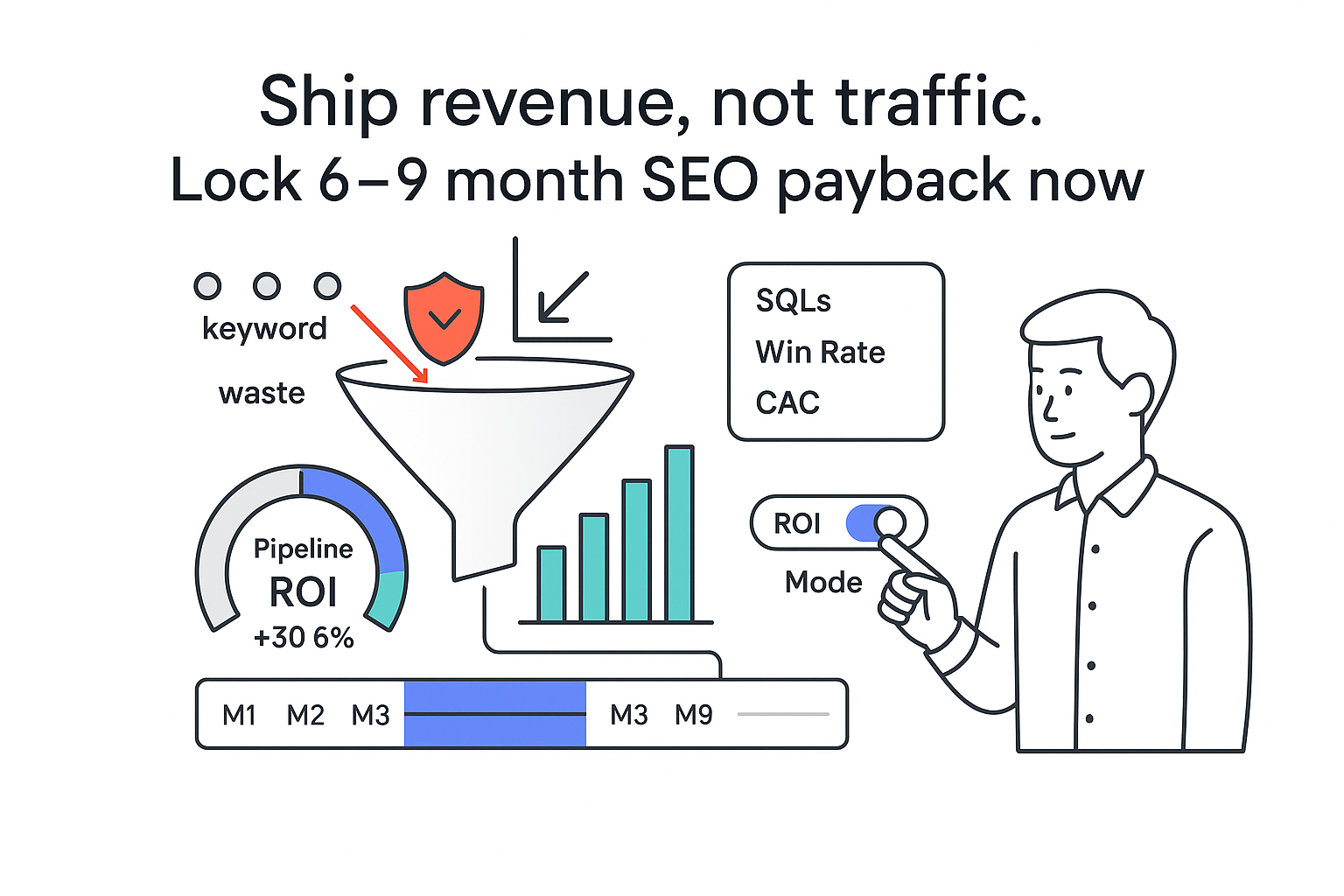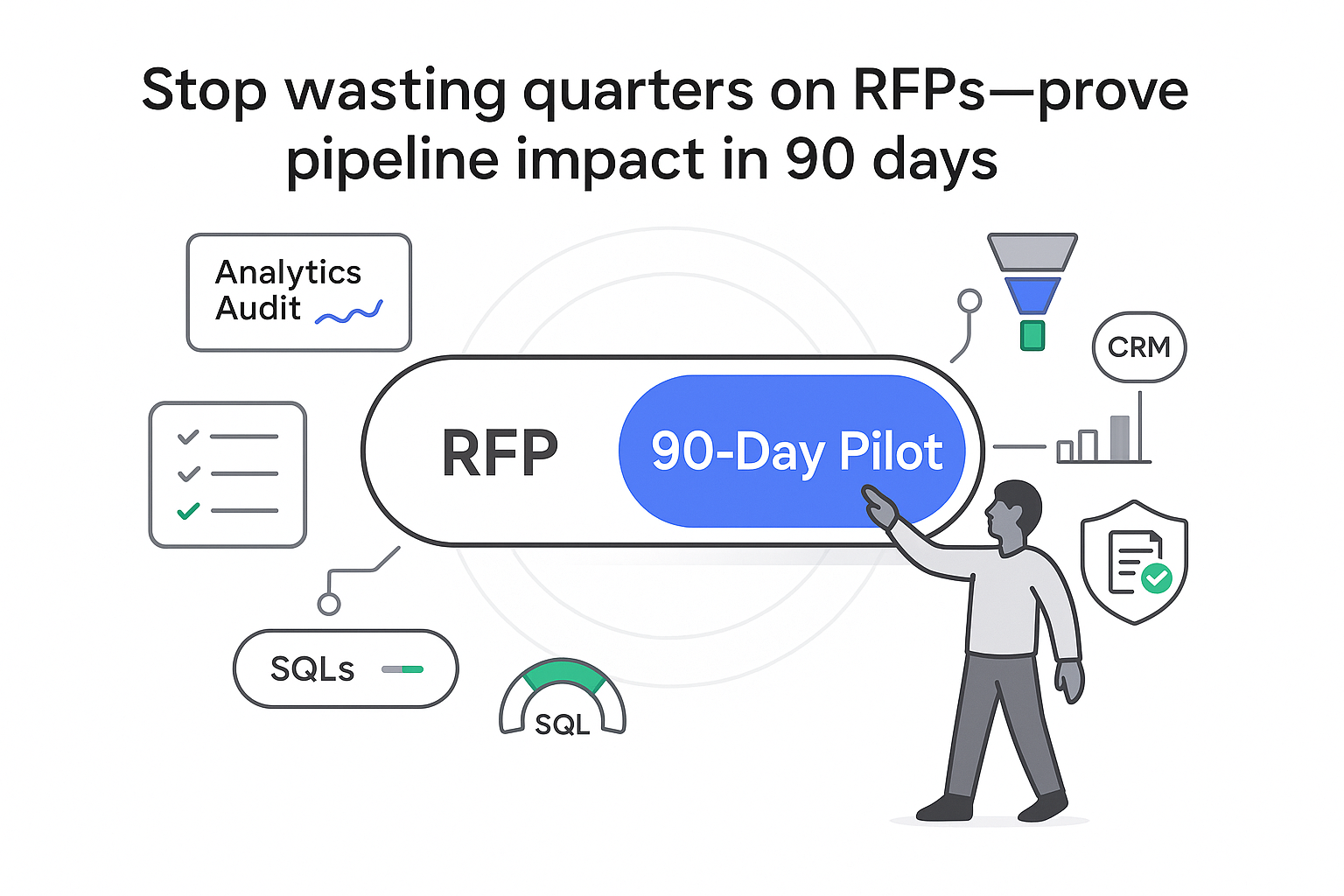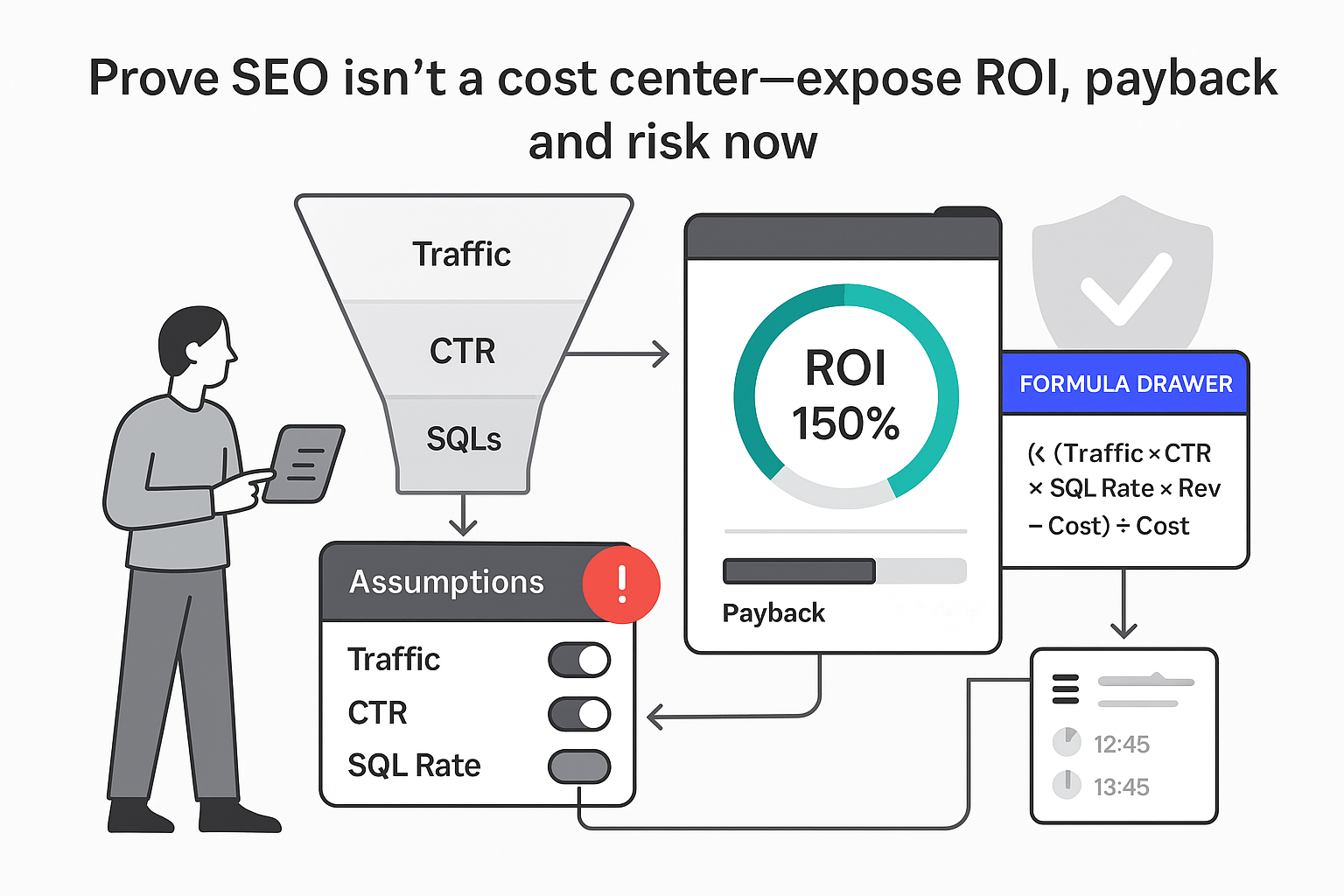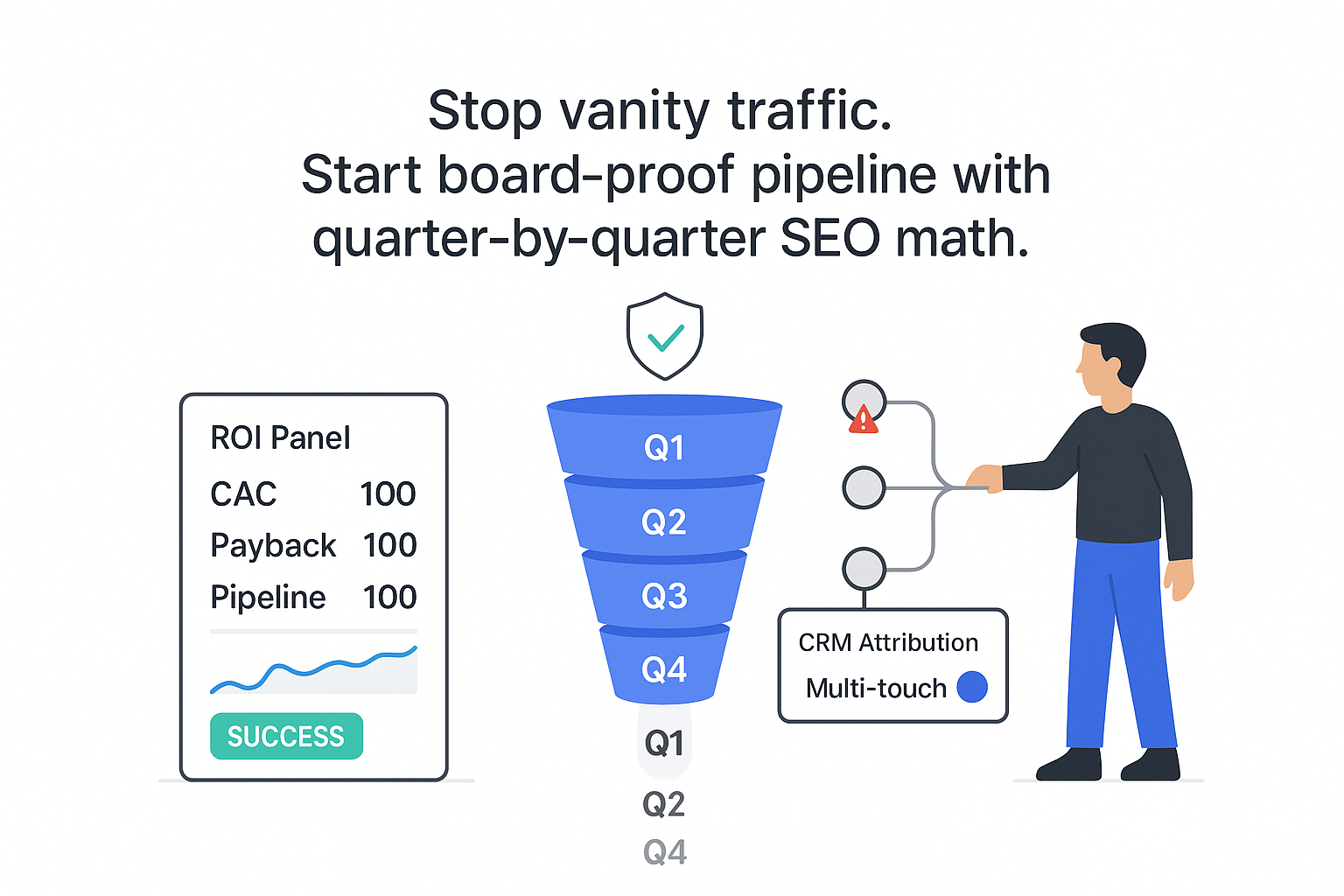You want a steady pipeline without babysitting vendors or reading a thesaurus. You want simple math, clear milestones, and someone who owns the number. If that sounds like you, keep reading. I wrote this guide for B2B service CEOs who want a dependable organic growth engine that cuts acquisition costs and lifts revenue with real accountability. I will talk ROI in plain English, give you a timeline you can sanity check, and map execution paths so you do not have to micromanage.
Abstract: B2B SEO outlook
B2B SEO can lift organic pipeline by 30 to 60 percent in 6 to 12 months for service businesses with product-market fit and a sales motion already closing deals. Expect the first sales-qualified leads within 12 to 16 weeks if site foundations are healthy and content matches buyer intent. I target CAC payback inside 6 to 9 months and contribution margin north of 60 percent by month 12 on organic opportunities. A credible in-house team or partner should tie effort to revenue-linked KPIs, report weekly, and show forecast vs. actual. These ranges reflect what I typically see across B2B services; adjust for baseline traffic, competitive intensity, and sales cycle length.
B2B SEO ROI
Here is the simple ROI model you can gut check in five minutes. Treat the figures as placeholders and adjust them to your reality.
Inputs
- Monthly investment: 12 thousand dollars (agency or equivalent in-house run rate)
- Sales cycle: 90 days
- Average deal size (ACV): 50 thousand dollars
- Win rate: 20 percent
- MQL to SQL rate: 35 percent
- Non-brand organic growth: 8 to 12 percent compound monthly after month 3 if a healthy baseline exists
- Definitions: an MQL is a qualified inbound lead that matches ICP; an SQL is accepted by sales and enters an active opportunity
Outputs
- Month 0 to 3: groundwork, minor lift from fixes and quick pages
- Month 4 to 6: first wave of ranked pages and link wins push MQLs up 20 to 40 percent
- Month 7 to 12: compounding content and links raise SQL volume 30 to 60 percent; pipeline follows
CAC payback
- Spend 12 thousand per month for 9 months equals 108 thousand
- Assume 40 MQLs from organic per month by month 9; 35 percent move to SQL gives 14 SQLs
- At a 20 percent win rate, you close almost 3 deals a month
- With a 50 thousand average deal size, revenue is about 150 thousand per month from organic by month 9
- CAC payback typically lands around month 7 to 9 depending on baseline and sales duration
Contribution margin
- After month 12, steady-state content maintenance and PR costs drop relative to output
- Contribution margin on organic-sourced deals often reaches 65 to 80 percent because content keeps working
Mini framework to plan and forecast
Quick wins, 0 to 90 days
- Technical cleanup, indexation, page speed, schema, and internal links
- Refresh high-intent pages and republish with better structure
- Repurpose winning sales assets into search pages
Compounding growth, 3 to 9 months
- Consistent net-new pages aimed at buying jobs, plus digital PR for authority
- Topic clusters that support core services and pain points
- Rank velocity picks up as trust builds
Scale, 9 to 18 months
- Expand to new verticals, new problems, and comparison content
- Strengthen lead quality with better bottom-funnel assets and CRO
- Add localized or partner pages if relevant
Accountability is the make-or-break. I set revenue-linked KPIs with one named owner per metric and a reporting cadence you can set your watch by.
Owners and KPIs
- Non-brand clicks and rank velocity: SEO lead
- MQL to SQL rate: demand lead with sales ops support
- Pipeline value and win rate: sales leader with marketing partnership
- CAC payback and contribution margin: CFO or finance partner
Cadence
- Weekly: traffic, rank movers, indexation, new links, in-flight content
- Monthly: MQLs, SQLs, pipeline, pages that pay, link velocity, gaps
- Quarterly: forecast vs. actual, marginal CAC, content mix shifts, strategy reset
Metrics for cost-effective SEO
Think measurement stack, not a random pile of charts. The goal is simple: prove that non-brand visibility creates qualified demand that turns into revenue at a lower CAC than paid channels. Keep the taxonomy tight and definitions consistent with sales ops.
Primary KPIs
- Non-brand organic clicks and impressions in Google Search Console
- MQL to SQL rate from organic in your CRM
- Pipeline value and revenue from organic-sourced opportunities
- Win rate and sales cycle length for organic-sourced deals
Secondary KPIs
- Rank velocity across a tracked set of revenue keywords in STAT or Ahrefs
- Indexation and coverage in Search Console
- Crawl health and page performance from Screaming Frog and Lighthouse
- Link velocity and referring domains from Ahrefs or Semrush
Decision KPIs
- CAC payback on organic programs
- LTV to CAC ratio for organic-sourced cohorts
- Contribution margin at 6, 9, and 12 months
Sample dashboard layout and reporting cadence
- Top row: non-brand clicks trend, MQLs from organic, SQLs from organic, pipeline created
- Middle row: rank velocity by theme, content output vs. plan, link velocity
- Bottom row: pages that drive SQLs, time to index, CRO performance on high-intent pages
Use GA4 for sessions and conversions, Google Search Console for query data, Salesforce or HubSpot for source tracking, and Looker Studio or Power BI for a clean board. Align attribution rules with sales ops. If CRM source tagging is off, fix that before you judge ROI.
Timeline for SEO results in B2B sectors
Stage-based expectations shift with sales cycle length.
Short cycle, 30 to 60 days
- Week 1 to 4: site audit, fixes in sprint one, map buying jobs, build first briefs
- Week 6 to 8: first 4 to 6 pages live, early technical uplift, internal links added
- Week 8 to 12: link outreach begins, first rank movements on mid-tail terms
- Week 12 to 16: first SQLs for high-intent pages if competition is moderate
Mid cycle, 60 to 120 days
- Expect the first wave of SQLs in months 3 to 5, then steady gains through month 9
- Compounding effect often starts around month 4 as clusters mature
Long cycle, 120 plus days
- SEO work can produce MQLs within 8 to 12 weeks, but revenue tags later due to sales duration
- Forecast pipeline creation now; revenue lag follows your sales norm
I contrast this with paid. Paid can switch on demand but CAC is often higher and volatile. SEO takes a few months to warm up, then feeds the pipeline at a lower marginal cost. Many CEOs run paid for coverage while SEO ramps, then trim bids as organic shoulders more weight.
Milestones you can hold your team to
- Week 2: audit complete with fixes prioritized
- Week 4: technical fixes done or scheduled, content calendar locked
- Week 6 to 8: 4 to 6 strategic pages live with internal links and schema
- Week 8 to 12: link velocity reaches 5 to 15 quality links per month depending on your niche
- Week 12 to 16: first SQLs from organic, or a clear plan to close the gap if the niche is tougher
Options for execution and top SEO strategies for B2B businesses
Three paths work. You can hire a specialized B2B SEO agency, build in-house, or run a hybrid model. Each has a clear owner, speed to impact, level of control, cost, and risk.
Agency
- Owner: agency lead with your marketing leader
- Speed: fastest to first results if they have proven playbooks in your niche
- Control: lower hands-on control, higher strategic guidance
- Cost: fixed monthly fee, usually lower than a full in-house team early on
- Risk: outcomes depend on accountability and fit
In-house
- Owner: your SEO lead and content manager
- Speed: slower to first results, stronger control long term
- Cost: higher fixed cost, but unit economics improve at scale
- Risk: gaps in PR and links, risk of silos
Hybrid
- Owner: fractional SEO lead plus agency pods or freelancers
- Speed: quick to ramp with clear handoffs
- Cost: flexible, can scale up or down
- Risk: coordination overhead if roles are unclear
Top SEO strategies that move revenue
Buyer job mapping
- Build content around buying jobs like evaluate vendors, compare solutions, justify budget, and mitigate risk
- Examples: comparison pages, ROI calculators, security and compliance pages, implementation guides
Bottom funnel before top funnel
- Fix and expand service pages, use cases, industries, and FAQs that sales already uses
- Add proof elements like case snippets, policy summaries, and integration details
The cluster model
- Create a core page for each service and support it with 6 to 10 specific subtopics
- Cross-link within the cluster to pass authority
Digital PR with purpose
- Secure links from relevant publications, associations, and partners
- Use Connectively, Qwoted, and niche newsletters, and publish data-backed briefs
CRO threads the needle
- Use clear CTAs, social proof, and forms that match intent
- Test lead gen offers that fit B2B buyers such as audit summaries, evaluation templates, or architecture notes
Teams often rely on
- Research and tracking: Ahrefs, Semrush, STAT, Google Search Console
- Technical: Screaming Frog, Sitebulb, PageSpeed Insights
- Content: Clearscope, Surfer, generative AI for first drafts with human edits
- Reporting: Looker Studio, BigQuery, HubSpot or Salesforce for closed-loop tracking
Best SEO agency for B2B service companies
A simple scorecard saves me months of pain. Here are criteria that matter and red flags to avoid.
Selection criteria
- B2B specialization and sales cycle fluency
- Ask for case studies that show pipeline and revenue, not just traffic
- Forecast method
- They should model traffic to MQL to SQL to revenue with your win rate and ACV
- Content operations maturity
- Clear process for research, briefs, SME interviews, editing, and QA
- Digital PR and link systems
- Real sources, measured link velocity, and risk control
- Technical SEO depth
- Indexation, architecture, internal links, schema, speed, log-file analysis if needed
- Sales enablement content
- Security, compliance, integration, and implementation content that shortens time to close
- Reporting transparency
- Weekly snapshots, monthly pipeline reviews, and QBRs tied to revenue KPIs
- Incentive alignment
- A portion of fees tied to revenue or SQL targets, or at least to mutually agreed KPIs
Red flags
- Vanity metrics and keyword counts without business impact
- No ownership of outcomes, only activity logs
- Unclear link sources or volume promises that sound too good to be true
- One-size-fits-all page templates that ignore your buyer jobs
- A content plan that starts with top-funnel fluff before bottom-funnel gaps are closed
I ask reference clients two things: Did they hit the forecast within plus or minus 20 percent by month six? When things slipped, did they own the number and present a fix I could believe?
In-house SEO
Resourcing and total cost of ownership matter. Here is how I look at it.
Team setup
- SEO lead or strategist
- Technical SEO specialist
- Content lead and one to two writers
- Digital PR or outreach manager
- Part-time designer and developer support
Monthly cost bands in major markets
- SEO lead: 8 to 12 thousand
- Content lead: 7 to 10 thousand
- Writers: 4 to 7 thousand each
- Technical SEO: 7 to 10 thousand
- PR or outreach: 6 to 9 thousand
- Tools and misc: 1 to 3 thousand
All in, you are at 30 to 45 thousand per month for a proper in-house function. I find this works well when budgets are stable, content is close to your core IP, and you can hire and retain strong people. Risks include slower speed to first results, silos that disconnect SEO from sales, and PR gaps that stall authority growth.
A phased hybrid path
- Phase one: fractional SEO lead sets the strategy and forecast; agency pods deliver content and links
- Phase two: hire a content lead and a writer; keep the agency for PR and technical work
- Phase three: bring PR or outreach inside if you already have strong partnerships; retain the agency for special projects
I keep a simple rule: one person owns the number. Everyone else owns a part of the machine.
Improving search rankings for B2B services: Conclusion
Here is the decision map in plain language. If speed and accountability sit at the top of your list, hire a specialized B2B SEO agency that accepts revenue-linked KPIs and meets weekly. If control and long-term cost efficiency matter more, start with an agency to build the playbook, then bring it in-house over 6 to 12 months once the system runs. If you want the balance of speed and control, go hybrid with a fractional SEO lead and agency pods, then in-source by function.
Restate the numbers you can expect when the work is done right: a 30 to 60 percent lift in organic pipeline within 6 to 12 months; CAC payback in 6 to 9 months for most service firms with healthy sales motions; contribution margin that improves quarter by quarter because content compounds. Timelines shift by cycle length, and milestones by week let you keep score without micromanaging.
One last note on focus. Seasonality matters. Many teams see Q4 research spikes in software and services, with budget planning cycles driving interest. Plan your content three months ahead of those windows so pages are live and indexed when buyers start searching. Keep your measurement stack tidy. Tie every major page to at least one revenue keyword and one sales task. Use simple reports. Measure weekly. Iterate monthly. Adjust the plan each quarter.
I know the work is landing when three signals line up: rank velocity for bottom-funnel terms, SQL volume from organic, and a clear path to payback inside the target window. When those show up together, you can scale with confidence.







.svg)